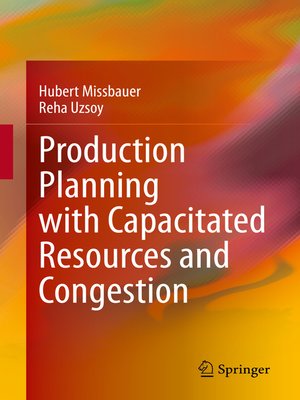Production Planning with Capacitated Resources and Congestion
ebook ∣ Business and Management
By Hubert Missbauer

Sign up to save your library
With an OverDrive account, you can save your favorite libraries for at-a-glance information about availability. Find out more about OverDrive accounts.
Find this title in Libby, the library reading app by OverDrive.



Search for a digital library with this title
Title found at these libraries:
| Library Name | Distance |
|---|---|
| Loading... |
This book presents a comprehensive overview of recent developments in production planning. The monograph begins with an introductory chapter reviewing the need for these production planning models, that operate by determining time-phased releases of work into the facility or supply chain, relating these to the Manufacturing Planning and Control (MPC) and Advanced Planning and Scheduling (APS) frameworks, that form the basis of most academic research and industrial practice. The extensive body of work on Workload Control is also placed in this context, and proves the need for improved models with a discussion of the difficulties, these approaches encounter.
The next two chapters present a detailed review of the state of the art in optimization models based on exogenous planned lead times, and examines the cases where these can take both integer and fractional values. The difficulties arising in estimating planned lead times are consistent with factory behavior which are highlighted, noting that many of these lead to non-convex optimization models. Attempts to address these difficulties by iterative multimodel approaches, that combine simulation and mathematical programming, are also discussed in detail. The next three chapters of the volume address the set of techniques developed using clearing functions, which represent the expected output of a resource in a planning period, as a function of the expected workload of the resource, during that period.
The chapters on this subject propose a basic optimization model for multiple products, discuss the difficulties of this model and some possible solutions. It also reviews prior work, and discuss a number of alternative formulations of the clearing function concept with their respective advantages and disadvantages. Applications to lot sizing decisions and a number of other specific problems are also described. This volume concludes with an assessment of the state of the art described in the volume, and several directions for future work.
The next two chapters present a detailed review of the state of the art in optimization models based on exogenous planned lead times, and examines the cases where these can take both integer and fractional values. The difficulties arising in estimating planned lead times are consistent with factory behavior which are highlighted, noting that many of these lead to non-convex optimization models. Attempts to address these difficulties by iterative multimodel approaches, that combine simulation and mathematical programming, are also discussed in detail. The next three chapters of the volume address the set of techniques developed using clearing functions, which represent the expected output of a resource in a planning period, as a function of the expected workload of the resource, during that period.
The chapters on this subject propose a basic optimization model for multiple products, discuss the difficulties of this model and some possible solutions. It also reviews prior work, and discuss a number of alternative formulations of the clearing function concept with their respective advantages and disadvantages. Applications to lot sizing decisions and a number of other specific problems are also described. This volume concludes with an assessment of the state of the art described in the volume, and several directions for future work.







